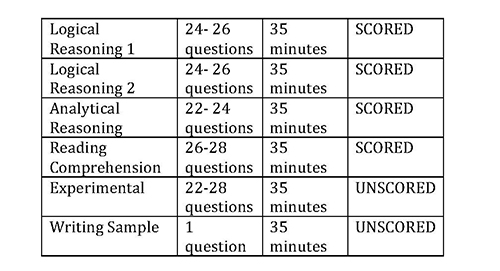About the LSAT
The Law School Admission Test (LSAT) is a half-day standardized test, administered by the Law School Admission Council four times each year at designated testing centers throughout the world. The exam is designed to measure a student’s critical thinking, comprehension, analytical and logical skills to assess an applicant’s likelihood of success in law school.
The test consists of five 35-minute sections of multiple-choice questions. Four of the five sections are scored and may come in any order. In addition, there will be a writing exercise, which will be sent to every law school you apply to. See below for breakdown.
James Lorie, a senior test developer of the Law School Admission Council provides an overview of the LSAT composition and discusses how to best prepare for the 3 ½ hour exam. Click here to watch the video.
When to take the test?
The LSAT is administered 4 times a year: June, September/October, December and February. Research each school’s application deadline and decide which academic semester is an appropriate time to apply. Many law schools require that the LSAT be taken by December to qualify as a candidate for admission the following fall.
Click here to view test dates and deadlines on the LSAC website.
Key factors to think about before selecting an LSAT date:
- Law school application deadlines
- LSAT registration deadlines
- Preparation time
- Your GPA
- Personal goals
Applicants cannot take the LSAT more than three times in a two-year period.
Where to take the LSAT?
Each applicant must sign-up for an account on the LSAC site and register for an LSAT test date and test center. You should register as early as possible because there are limited seats at each location. Find the closest test center here.
What are the fees?
LSAT – $165
Credential Assembly Service (CAS) – $160
For all other fees and fee waiver information, click here.
How to prepare for the exam?
The main goal is to simulate an actual testing experience as closely as possible. You should become familiar with the instructions and different types of questions. Take practice tests under timed conditions so you can determine how much time to spend on each question in a section.
You can enroll in a prep course where you will be trained on test-taking techniques and learn new strategies. Keep in mind that most services will charge a fee.
You can also choose to self-study by taking previously administered exams and reviewing preparation books. The LSAC also offers a variety of free materials. Click here to view.
You’ll receive notification of your LSAT score approximately three weeks after you take the exam. Your raw score is based on the number of correct answers, which is then converted to an LSAT scale on a range from 120 – 180 with 120 as the lowest score and 180 as the highest score.
A percentile rank is also reported along with each LSAT score, representing how you scored compared with others who have taken the test. Your scores will only be released to you and the law schools to which you applied.
If you wish to cancel your score, you can submit a written request that must be received by LSAC within six calendar days of the test or you can also write on your answer sheet the day of the test. More information.
Outcomes
After you receive your score, compile a list of prospective schools and categorize them into safety schools, target schools and reach schools.
If you are unsatisfied with your initial score, determine whether you should retake the exam. Also, be sure to check each school’s policies on how they view multiple LSAT scores. Some admission committees take the highest score and some consider all scores in the process.
Ask yourself:
- What can you do differently?
- Are you willing to invest additional time/money for more prep?
- Is it worth the risk? You have a chance to improve your score, but will it be a significant difference?
Talk to pre-law advisers, faculty, and community members in the legal profession to help with your final decisions.


